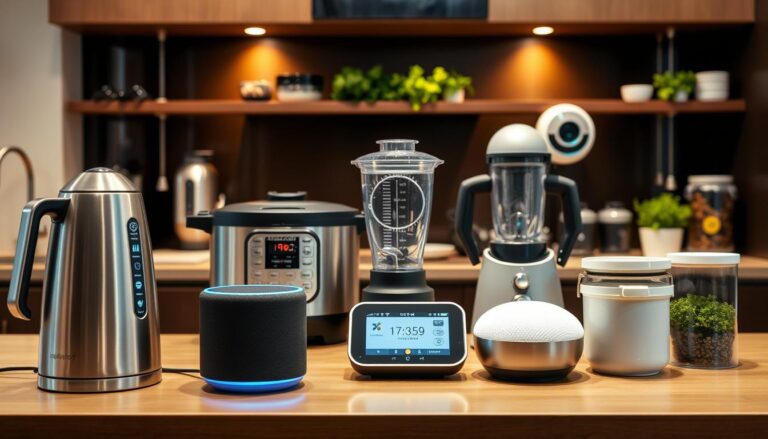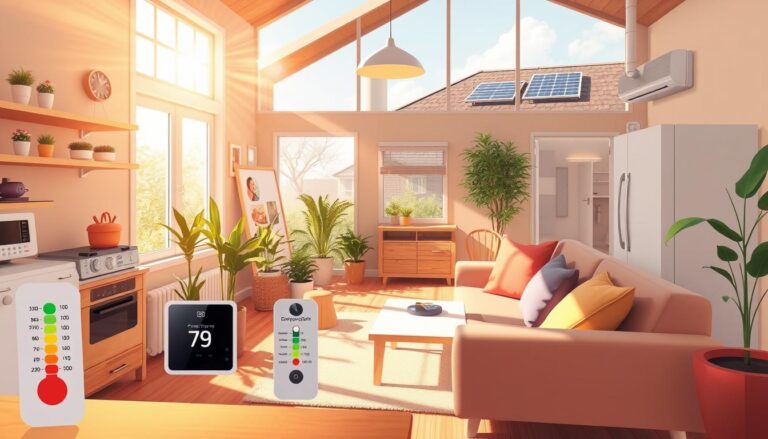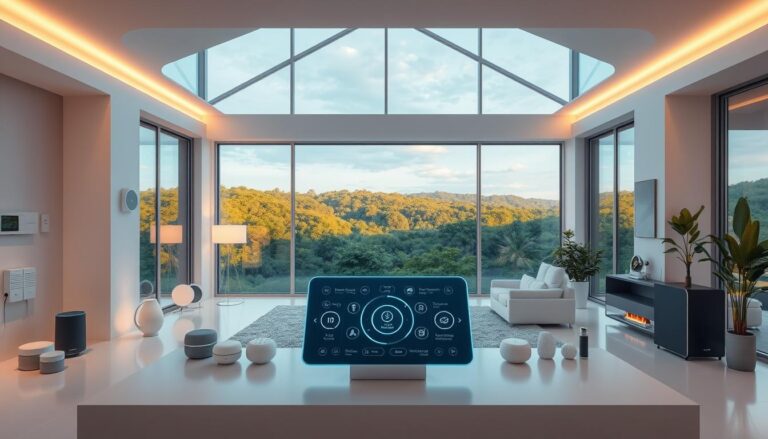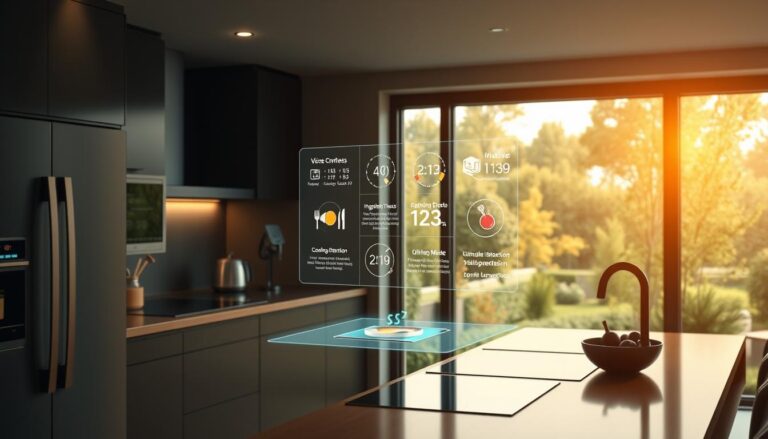Energy-Saving Tips for Smart Homes
Smart home systems are transforming the way we manage our households. By integrating advanced technologies, these systems offer a seamless way to control devices, optimize energy use, and reduce costs. With the global number of smart homes projected to exceed 670 million by 2027, it’s clear that this trend is here to stay1.
One of the most significant advantages of a smart home is its ability to cut down on energy consumption. For example, smart thermostats can save households an average of $225 annually by adjusting temperature settings based on occupancy2. Similarly, smart lighting systems can reduce energy usage by 10-30%, depending on how they’re configured2.
Planning is key to maximizing the benefits of a smart home. By creating a compatibility plan and automating devices, you can ensure your system runs efficiently. This not only leads to savings but also makes your home more comfortable and environmentally friendly.
Key Takeaways
- Smart home systems can reduce energy consumption by up to 30% when used effectively2.
- Smart thermostats save households an average of $225 annually2.
- Smart lighting systems can cut energy usage by 10-30%2.
- Planning and automation are essential for maximizing energy savings.
- Smart homes contribute to lower carbon footprints and increased comfort.
Introduction: The Growth of Smart Homes and Energy Efficiency
The rise of smart homes is reshaping how we interact with our living spaces. With advancements in technology, homeowners now have access to devices that simplify daily tasks and improve efficiency. From voice assistants to remote controls, these innovations are redefining household management.
Understanding the Modern Smart Home Landscape
Smart home technology has evolved significantly over the past decade. Products like the Google Nest Learning Thermostat have set the standard for energy-efficient devices. These systems learn your habits and adjust settings to optimize temperature and reduce energy use3.
Compatibility between devices is crucial for seamless integration. Planning ensures that your smart home system works efficiently, saving both time and money. For example, smart lighting can cut energy consumption by up to 80% compared to traditional bulbs3.
Why Energy Efficiency Matters for Homeowners
Energy efficiency is a top priority for many homeowners. Smart thermostats can save up to 15% on heating and cooling bills3. Real-time energy monitors help identify consumption patterns, leading to further savings3.
Beyond cost savings, these systems contribute to a greener planet. By reducing energy use, smart homes help lower carbon footprints. This makes them an attractive option for environmentally conscious individuals.
Understanding the potential and limitations of current technology is key. With proper planning, you can create an energy-savvy household that meets your needs.
Energy-saving tips for smart homes

Maximizing energy savings begins with thoughtful device integration. A well-planned system ensures your devices work together seamlessly, reducing energy waste and lowering costs. Start by drafting a compatibility plan that lists your desired devices and verifies their integration capabilities. For example, check if an Amazon Echo Dot can connect with your security system or smart thermostat4.
Creating a Compatibility and Integration Plan
Begin by identifying the devices you want to include in your smart home. Ensure they can share data and work in unison. For instance, a smart thermostat should integrate with your lighting system to optimize energy use based on occupancy4. This approach not only improves efficiency but also reduces long-term costs.
Check for third-party verifications like Energy Star certifications. These confirm that devices meet stringent energy efficiency standards5. A well-integrated system can save up to 30% on energy bills, making it a worthwhile investment4.
Automating Devices for Maximum Savings
Automation is key to unlocking the full potential of your smart home. Devices like smart thermostats and lighting systems can learn your habits and adjust settings automatically. For example, smart blinds can close during the hottest parts of the day, reducing the need for air conditioning4.
Set up schedules and machine learning routines to ensure your system operates efficiently. Smart washers and dryers can run cycles during off-peak hours, saving on utility bills4. Regular monitoring of energy use through your system can reveal trends and peak usage times, aiding in better energy management5.
| Device | Integration Benefit | Potential Savings |
|---|---|---|
| Smart Thermostat | Adjusts temperature based on occupancy | Up to $225 annually4 |
| Smart Lighting | Reduces energy usage by 10-30% | Up to 80% compared to traditional bulbs4 |
| Smart Blinds | Optimizes natural heating and cooling | Reduces AC usage by 20%4 |
By focusing on compatibility and automation, you can create a smart home that not only saves money but also contributes to a greener planet. Start planning today to enjoy the benefits of an energy-efficient household.
Optimizing Your Smart Device Settings and Firmware
Customizing your smart devices can significantly improve their efficiency and fit your daily routine. Default settings are often not the most energy-efficient, so adjusting them to match your lifestyle is essential. For example, a smart thermostat can be programmed to lower the temperature when you’re away, saving up to 15% on heating and cooling bills6.
Customizing Device Settings to Match Your Lifestyle
Tailoring your smart home settings ensures they align with your habits. Automation schedules can power down devices when not in use, reducing unnecessary energy consumption. For instance, smart lighting systems can be set to turn off during daylight hours, cutting energy use by up to 30%6.
Real-time energy monitors can help identify patterns and optimize usage. By analyzing data, you can make informed decisions about when to run appliances or adjust temperatures. This approach not only saves money but also enhances overall efficiency.
Updating Firmware for Enhanced Performance
Regular firmware updates are crucial for maintaining your smart home system. These updates often include bug fixes, performance improvements, and new energy-saving features. For example, updating a smart thermostat can unlock advanced scheduling options that further reduce energy waste6.
Many manufacturers now offer automatic updates, ensuring your devices stay up-to-date without manual intervention. This is particularly useful for routers and other critical components that affect connectivity and performance.
| Device | Optimization Benefit | Potential Savings |
|---|---|---|
| Smart Thermostat | Adjusts temperature based on occupancy | Up to 15% on bills6 |
| Smart Lighting | Automates on/off schedules | Up to 30% energy reduction6 |
| Smart Plug | Monitors and controls energy use | Reduces standby power loss7 |
By customizing settings and keeping firmware updated, you can maximize the efficiency of your smart home. These steps not only save money but also contribute to a more sustainable lifestyle.
Establishing a Reliable Smart Home Network
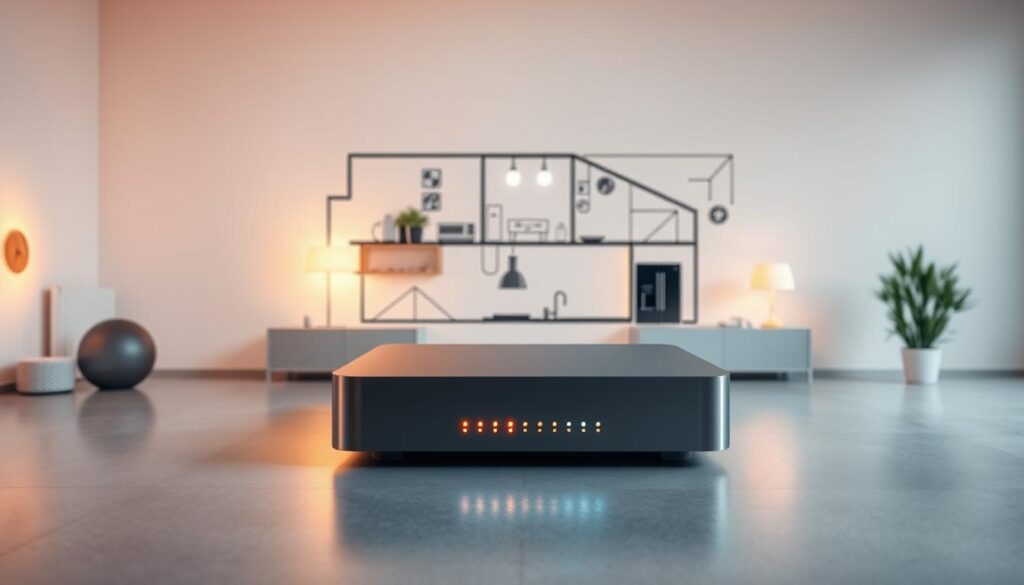
A reliable network is the backbone of any efficient smart home system. Without it, even the most advanced devices can struggle to perform. A strong network ensures seamless connectivity, enabling your devices to work together harmoniously.
Building a Robust Wi-Fi Infrastructure
Start by placing your router in a central location to maximize coverage. Avoid obstacles like walls or large furniture that can weaken the signal. For larger homes, consider a mesh network system to eliminate dead zones and ensure consistent connectivity8.
Invest in energy-efficient routers that support the latest Wi-Fi standards, such as Wi-Fi 6E. These routers not only improve performance but also consume less power, contributing to overall savings8.
Ensuring Seamless Device Connectivity
Choose an internet service package with sufficient bandwidth to support multiple devices. A stable connection is essential for automated controls and remote management of your smart home system9.
Regularly monitor your network’s performance and adjust settings as needed. Tools like real-time energy monitors can help identify and resolve connectivity issues, ensuring your devices operate efficiently10.
- Place your router centrally to maximize coverage.
- Use mesh networks to eliminate dead zones in larger homes.
- Invest in energy-efficient routers with Wi-Fi 6E support.
- Select an internet package with sufficient bandwidth.
- Monitor and adjust network settings for optimal performance.
By focusing on these steps, you can create a reliable network that supports your smart home’s needs. This not only enhances performance but also helps reduce energy waste and save money in the long run.
Leveraging Smart Appliances for Energy and Water Savings
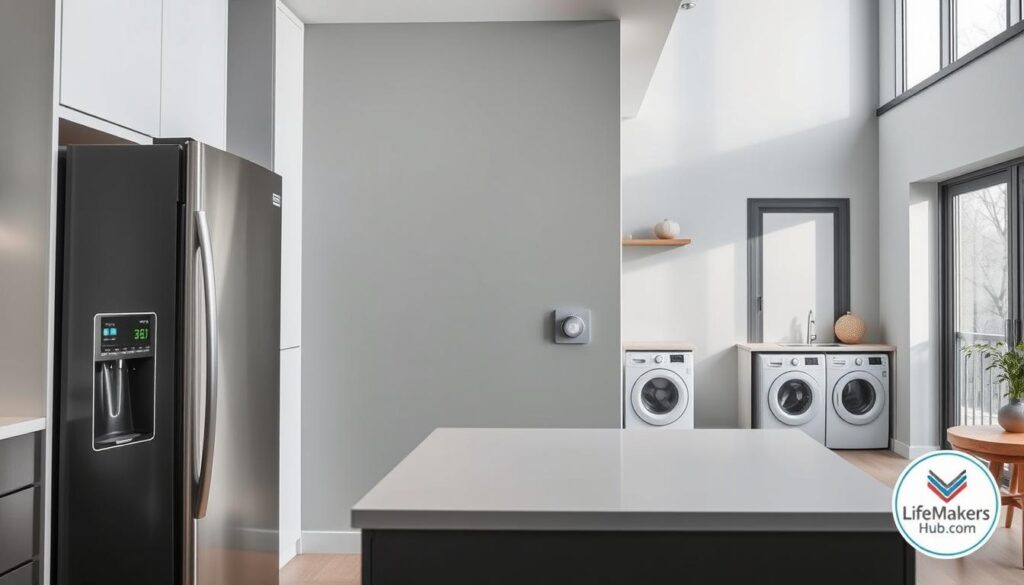
Smart appliances are revolutionizing how we manage resources in our homes. These devices not only simplify daily tasks but also help reduce energy and water consumption. By integrating advanced technology, homeowners can achieve greater efficiency and sustainability.
Smart Lighting and Power Control Methods
One of the easiest ways to save energy is by upgrading to smart lighting. LED bulbs consume up to 75% less energy than traditional incandescent bulbs11. Pair them with in-wall switches or smartphone apps for remote control, ensuring lights are only on when needed.
Smart power strips are another game-changer. They eliminate phantom energy drain, which can account for 5-10% of a typical household’s energy bill11. By shutting off devices that draw standby power, these strips help reduce unnecessary energy use.
Utilizing Smart Appliances to Monitor Resource Usage
Smart appliances like dishwashers, washers, and microwaves can monitor resource usage and adjust operations for better efficiency. For example, scheduling these devices to run during off-peak hours can lower electricity costs12.
Integrating smart sensors can also prevent water wastage. Leak sensors detect issues early, avoiding costly damage and conserving water11. This proactive approach ensures your home operates efficiently while saving money.
By leveraging these technologies, you can create a more sustainable and cost-effective household. Start integrating smart appliances today to enjoy the benefits of reduced energy and water use.
Conclusion
Adopting smart technology in your home can lead to significant savings and improved efficiency. By automating devices like a smart thermostat, you can reduce energy use and lower your bill by up to 15%13. Small changes, such as upgrading to energy-efficient bulbs, can also make a big difference over time.
To maximize savings, focus on compatibility and regular updates. A well-integrated system ensures devices work seamlessly, cutting costs and reducing waste. For example, smart lighting can save up to 30% on energy consumption13.
Reassess your current setup and implement these strategies today. Simple adjustments can help save money while making your home more sustainable. Start small, plan wisely, and enjoy the benefits of a smarter, more efficient living space.
FAQ
How can smart thermostats help reduce energy bills?
What are the benefits of automating devices in a smart home?
How do I ensure my smart home devices work efficiently?
Why is a strong Wi-Fi network important for a smart home?
Can smart lighting really save money?
How do smart appliances contribute to water and energy savings?
What should I consider when integrating smart devices into my home?
Source Links
- How to Save Money and Energy With Smart Home Devices
- How smart home products can save money and energy
- Smart Home Tech That Enhances Home Efficiency
- Five Tips for Making Your House an Energy-Saving Smart Home
- 11 Ways to Optimize Your Smart Home Energy Efficiency
- Tips and best practices for optimizing your smart home
- Smart Home Energy Saving Tips and Devices | Constellation
- The Ultimate Guide to Setting Up Your Smart Home
- How to Set up Your Smart Home
- How to Set Up Your Smart Home: A Beginner’s Guide
- How to Reduce Energy Bills with Smart Home Technology – One Hour Air Conditioning & Heating Fort Worth TX & North Dallas / Plano Area. Gladly servicing the Fort Worth and North Dallas Area.
- The 5 Best Smart Home Technologies to Maximize Your Energy Savings
- Smart home technology saves money and helps protect the planet | IoT Now News & Reports



